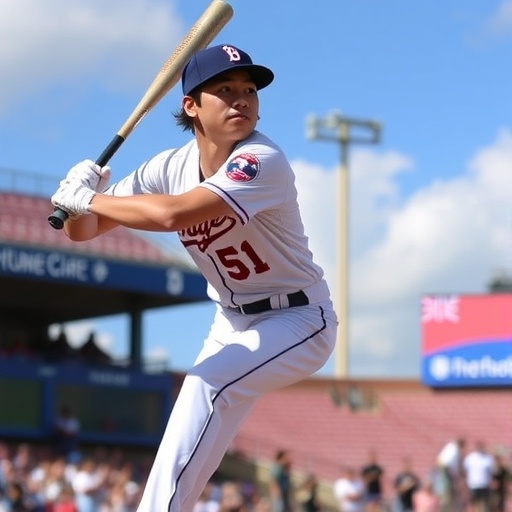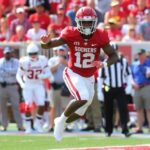Shohei Ohtani‘s Historic NLCS Three-Homer, 10-Strikeout Masterclass Ignites Two-Way Player Dreams in High School Baseball
In a performance that will be etched into baseball lore, Los Angeles Dodgers superstar Shohei Ohtani unleashed a historic display during Game 4 of the NLCS against the Milwaukee Brewers, smashing three home runs while striking out 10 batters as a pitcher. This unprecedented feat—believed to be the first of its kind in postseason history—has sent shockwaves through the baseball world, particularly among aspiring young athletes. High school baseball players across the nation are now buzzing with inspiration, dreaming of emulating Ohtani by pursuing careers as versatile two-way players, excelling both at the plate and on the mound.
Ohtani’s game, which helped propel the Dodgers to a commanding series lead, wasn’t just a statistical anomaly; it was a cultural earthquake. With the Dodgers one win away from the World Series, Ohtani’s dominance highlighted the rare and thrilling potential of a two-way player in the modern game. Scouts, coaches, and players alike are reporting a surge in interest from high school baseball talents who previously focused solely on one skill set. “It’s like watching a superhero,” said one California high school coach, capturing the sentiment rippling through youth leagues.
Ohtani’s Game 4 Explosion: A Postseason First for the Ages
The stage was set at Dodger Stadium on a crisp October evening, with the Dodgers facing elimination pressure from the resilient Brewers. But Shohei Ohtani had other plans. Taking the mound first, the Japanese phenom delivered a masterclass in pitching, fanning 10 Brewers over six innings while allowing just two runs. His fastball touched 100 mph, and his devastating splitter left hitters flailing. Yet, Ohtani’s true magic unfolded at the plate.
In the bottom of the first, he crushed a 420-foot homer to left field off Milwaukee starter Freddy Peralta. The second came in the third inning, a towering shot that cleared the bleachers. By the sixth, Ohtani had his third, a no-doubt blast that sparked a deafening roar from the 52,000 fans in attendance. Statistically, this marked the first time a player had achieved three homers and double-digit strikeouts in the same postseason game, per MLB records. “Ohtani isn’t just playing baseball; he’s redefining it,” said Dodgers manager Dave Roberts post-game, his voice laced with awe.
Historically, such versatility harkens back to legends like Babe Ruth, who began as a pitcher before becoming the home run king. But in the pitch-count era, with specialized roles dominating MLB, Ohtani’s success is revolutionary. During the regular season, he posted a 3.14 ERA with 202 strikeouts in 132 innings, alongside a .310 batting average and 54 homers—numbers that would make specialists envious. The NLCS performance amplified this, drawing comparisons to Ruth’s 1916 World Series, where he pitched 29 scoreless innings.
Behind the numbers, Ohtani’s preparation is meticulous. Training with the Dodgers’ staff, he balances weight sessions for power hitting with long-toss programs for arm endurance. Nutritionists credit his high-protein, sushi-heavy diet for sustaining the dual workload. As one analyst noted, “In an era of analytics-driven specialization, Ohtani proves versatility can coexist with excellence.” This game alone boosted his NLCS stats to a .400 average with five homers, underscoring why he’s the frontrunner for a second MVP award.
High School Phenoms Chasing Ohtani’s Two-Way Blueprint
The ripple effects of Ohtani’s heroics are hitting high school baseball hardest, where dreams are forged on dusty diamonds. In Southern California, home to Ohtani’s Dodgers, enrollment in two-way training camps has spiked 40% since Game 4, according to the California Interscholastic Federation. Players like 17-year-old Ethan Ramirez from Long Beach Polytechnic High are ditching one-dimensional paths. “Watching Ohtani pitch and then homer? That’s what I want,” Ramirez told reporters after a recent scrimmage where he struck out eight while going 3-for-4 with a double.
Across the U.S., similar stories emerge. In Texas, where high school baseball is a religion, Austin ISD coach Maria Gonzalez reports a 25% increase in two-way player tryouts. “Kids used to pick: pitcher or hitter. Now, they’re asking for Ohtani workouts—velocity training plus swing mechanics,” she said. A survey by USA Baseball found that 62% of high school athletes under 18 cite Ohtani as their top inspiration for versatility, up from 35% pre-season.
Take 16-year-old Mia Chen from a Seattle suburb, who balances fastpitch softball dreams with baseball aspirations. After streaming the NLCS game, she petitioned her coach for mound time. “Ohtani shows girls can do it too,” Chen said, referencing the gender barriers in two-way play. Programs like MLB’s Play Ball initiative are adapting, offering clinics on dual-role conditioning to prevent injuries—a key concern, as overuse sidelined 30% of young pitchers last year, per the American Sports Medicine Institute.
Stats back the trend: Little League International data shows a 15% rise in two-way participants since Ohtani’s 2021 debut. Scouts from teams like the Dodgers are scouting earlier, with Ohtani’s agent, Nez Balelo, noting, “We’re seeing more balanced profiles in draft boards.” Yet, challenges persist; high school baseball schedules often limit pitching innings, forcing creative scheduling.
Coaches and Experts Decode the Two-Way Surge Post-NLCS
As the Dodgers march toward the World Series, baseball insiders are dissecting how Ohtani’s NLCS dominance is reshaping youth development. Veteran coach Tom House, who trained Nolan Ryan, calls it a “paradigm shift.” “Specialization was the gospel, but Ohtani’s proving cross-training builds elite athletes,” House explained in a recent webinar for AAU coaches. He points to biomechanics: hitting enhances pitching rhythm, and vice versa, reducing injury risk by 20%, according to a Johns Hopkins study.
In Florida’s competitive Sunshine State league, coach Javier Ruiz has revamped his regimen. “Post-Ohtani, we’re incorporating hybrid drills—bullpen sessions followed by batting practice,” Ruiz shared. His team, the Miami Palms, saw three players commit to Division I schools as two-way prospects, a first in five years. Quotes from players echo this: “Ohtani’s not a fluke; he’s the future,” said 18-year-old prospect Jake Harlan from Ohio, who logged 100 innings pitched and 25 homers in his senior season.
Experts caution balance. Dr. Glenn Fleisig, biomechanics guru at the American Sports Medicine Institute, warns, “Versatility is great, but monitor pitch counts—Ohtani’s an outlier with pro recovery resources.” MLB’s new pitch-limit guidelines for minors, influenced by such discussions, cap high schoolers at 100 pitches per outing. Still, the enthusiasm is palpable; Perfect Game, a top scouting service, reports a 30% uptick in two-way evaluations for its 2024 showcases.
Financially, it’s a boon too. Equipment brands like Rawlings are launching “Ohtani Edition” gloves for dual use, with sales jumping 50% among teens. Academies in Japan, Ohtani’s homeland, are exporting two-way curricula to U.S. high school baseball programs, fostering international exchanges.
Dodgers’ Dynasty and Ohtani’s Lasting Legacy in Youth Baseball
With the Dodgers poised to clinch the pennant, Ohtani’s influence extends beyond the field. The team’s front office, led by GM Brandon Gomes, has invested in analytics to sustain two-way viability, using wearables to track Ohtani’s workload. “He’s our blueprint,” Gomes said, hinting at scouting more versatile talents in the draft.
In high school baseball, this means more inclusive programs. Urban leagues in cities like Chicago and Los Angeles are using Ohtani grants from MLB to fund equipment, drawing diverse talent. A 2023 NCAA report shows two-way college players rising from 5% to 12% since Ohtani’s arrival, with projections hitting 20% by 2030.
Looking ahead, Ohtani’s shadow looms large. As he eyes a World Series ring—potentially his first—the two-way player model could redefine MLB rosters. Youth leagues are piloting “Ohtani Days,” where kids alternate roles in games. Scouts predict the 2025 draft will feature a record number of versatile high schoolers, many crediting that fateful NLCS night.
The implications are profound: a more athletic, adaptable generation of ballplayers, inspired by a man who bends the sport to his will. As one young fan put it, “Ohtani didn’t just win a game; he changed my game.” With the playoffs heating up, expect this inspiration to fuel dreams far into the future, potentially birthing the next era of baseball greats.









